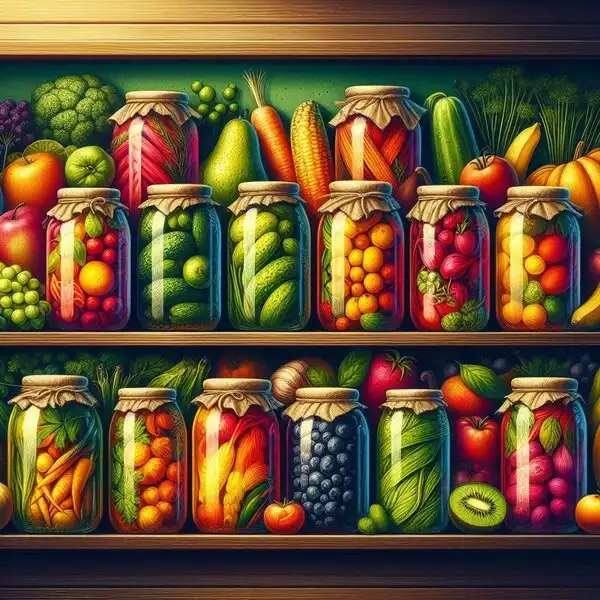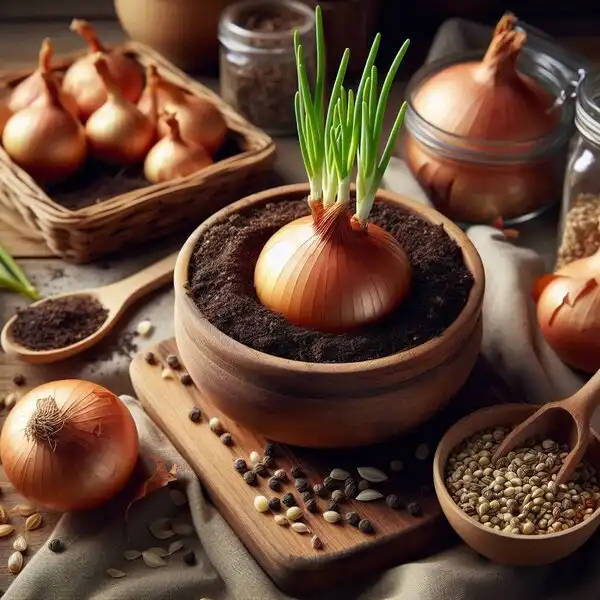Mastering Onion Cultivation: A Comprehensive Guide
Growing onions from seed opens up a world of benefits for the avid gardener. Unlock the potential of this rewarding journey with insights into why starting from seed is advantageous.

Unlocking the Benefits of Growing Onions from Seed
Growing onions from seed offers unparalleled control over your crop, ensuring you select the healthiest seeds for optimal growth. By eliminating reliance on external sources for onion sets, you embrace self-sufficiency in your garden.
Perfect Timing: When to Start Onion Seeds Indoors
Timing is critical when it comes to starting onion seeds indoors. Learn the ideal timeline to kickstart your onion growing journey and maximize bulb development.
Choosing Between Pelleted and Loose Onion Seeds
When selecting onion seeds, you may encounter pelleted and loose options. Explore the pros and cons of each to determine the best fit for your gardening needs.
Exploring Different Onion Varieties for Your Climate
Discover the diverse range of onion varieties tailored to various climates. Whether you're in a temperate zone or a warmer region, there's a suitable onion variety waiting to thrive in your garden.
Proven Tips for Successful Onion Seed Germination
Master the art of onion seed germination with proven techniques and insider tips. Set yourself up for success with tried-and-tested methods to ensure robust seedling growth.
From Seedling to Garden: Transplanting Onions
Transplanting onions marks a crucial stage in their journey from seed to harvest. Follow these steps to ensure a successful transition from seedling to garden.
Preparing Your Onion Seeds for Successful Transplant
Before transplanting onion seedlings, it's essential to prepare them adequately. Start by hardening off the seedlings, gradually exposing them to outdoor conditions to acclimate them to the elements. Ensure the seedlings are well-watered and healthy before transplanting.
When selecting a location for transplanting, choose a spot with well-drained soil and ample sunlight. Clear the area of any weeds or debris to provide a clean environment for the onion seedlings to thrive.
Best Practices for Transplanting Onion Seedlings
When transplanting onion seedlings, handle them carefully to avoid damaging the delicate roots. Dig small holes in the prepared soil, spacing the seedlings according to the recommended distance for the variety you're growing. Gently place each seedling into its hole, ensuring the roots are spread out and covered with soil.
After transplanting, water the seedlings thoroughly to help them establish in their new environment. Consider applying a layer of mulch around the seedlings to retain moisture and suppress weed growth.
Protecting Onions from Frost and Cold Snaps
Onions are resilient plants but may require protection from frost and cold snaps, especially in early spring. Keep an eye on weather forecasts and be prepared to cover your onion seedlings with row covers or cloches if temperatures drop unexpectedly.
Additionally, consider planting onions in raised beds or using mulch to help regulate soil temperature and protect the roots from extreme cold.
Signs Your Onions Are Ready for Harvest
As your onion plants mature, keep an eye out for signs that they're ready for harvest. Mature onions will develop bulbs that feel firm and solid to the touch. The foliage may also start to yellow and topple over, indicating that the bulbs have stopped growing.
Once you've observed these signs, it's time to harvest your onions. Use a garden fork or trowel to gently lift the bulbs from the soil, being careful not to damage them.
Seeds of Sustainability: Saving Onion Seeds
Preserving onion seeds is a sustainable practice that ensures a continuous supply of this essential crop for future plantings. Here's a comprehensive guide to saving onion seeds and promoting long-term self-sufficiency.
Dive into our article on Comprehensive guide to freeze dried berries preservation ideas for a complete overview. We cover all the essential points and provide a lot of useful information.
Insights into Saving Onion Seeds for Future Planting
When saving onion seeds, it's crucial to understand the plant's biennial nature. Onions are biennial crops, meaning they complete their life cycle over two growing seasons. In the first year, onions produce foliage and bulbs. In the second year, if left in the ground, they bolt, flower, and produce seeds.
To save onion seeds, allow a portion of your onion crop to overwinter in the ground. In the following growing season, the onions will send up flower stalks, known as scapes, which eventually produce seed heads filled with small black seeds.
Identifying Ideal Onions for Seed Saving
Not all onions are suitable for seed saving. Choose varieties that are open-pollinated or heirloom, as these will produce seeds that remain true to type. Avoid hybrid varieties, as the seeds may not produce offspring with the desired characteristics.
When selecting onions for seed saving, opt for healthy, disease-free bulbs that represent the traits you want to perpetuate in future generations. Allow these onions to fully mature and develop flower stalks in their second year.
Strategies for Maximizing Seed Yield
To maximize seed yield, ensure proper pollination by encouraging pollinator activity in your garden. Bees and other pollinators play a vital role in transferring pollen between onion flowers, resulting in viable seeds.
Our in-depth coverage on Insights into canning chicken gravy recipes provides a wealth of information and insights. Be sure to check it out for a comprehensive understanding of the topic.
Once the seed heads have matured and turned brown, carefully harvest them and allow them to dry in a well-ventilated area. Once dry, thresh the seed heads to separate the seeds from the chaff, then store the seeds in a cool, dry place for future use.
Planning for Long-Term Self-Sufficiency
Saving onion seeds is not only a practical way to ensure a consistent onion supply but also promotes self-sufficiency and resilience in the face of uncertain times. By mastering the art of seed saving, you empower yourself to take control of your food supply and reduce dependency on external sources.
Dive into our article on Learn the secrets of finance your homestead journey for a complete overview. We cover all the essential points and provide a lot of useful information.
As you embark on your journey toward long-term self-sufficiency, continue to educate yourself about sustainable gardening practices and seed-saving techniques. Explore further resources, such as books, online forums, and local gardening communities, to deepen your knowledge and skills.
Embracing Self-Reliance: Conclusion and Call to Action
Congratulations on completing your journey of mastering onion cultivation from seed! As you reflect on the knowledge gained and the experience acquired, it's essential to recognize the broader implications of your efforts.
Reflecting on the Journey of Growing Onions from Seed
Throughout this comprehensive guide, you've delved into the intricacies of onion cultivation, from selecting the right seeds to nurturing seedlings, transplanting them into your garden, and finally, saving seeds for future plantings. Each step of this journey has contributed to your understanding of sustainable gardening practices and your ability to grow a vital crop independently.
By embracing the principles of self-reliance, you've taken proactive steps toward reducing your dependency on external sources for essential food supplies. Your commitment to sustainable gardening not only benefits you and your family but also contributes to building a more resilient and environmentally conscious community.
Empowering Yourself Through Sustainable Gardening
As you continue to cultivate your garden and explore the possibilities of sustainable living, remember the empowerment that comes from taking control of your food production. Sustainable gardening is more than just a hobby; it's a lifestyle choice that promotes health, resilience, and environmental stewardship.
By growing your onions from seed, you've gained valuable skills and knowledge that can be applied to other aspects of your life. Whether you're growing vegetables, herbs, or fruits, the principles of sustainability remain the same: work in harmony with nature, minimize waste, and prioritize long-term self-sufficiency.
Take Action: Start Growing Onions from Seed Today
Now that you've learned the ins and outs of onion cultivation, it's time to put your knowledge into practice. Take the first step toward self-reliance by planting onions from seed in your garden. Whether you have limited space in a backyard garden or ample room on a rural homestead, there's always an opportunity to grow your food.
Remember, the journey of self-reliance begins with a single seed. By taking action today, you're investing in a more sustainable and resilient future for yourself and future generations.
Join Our Community for Ongoing Support and Tips
For ongoing support and guidance on your journey toward self-reliance, consider joining our vibrant community of like-minded gardeners and sustainability enthusiasts. Connect with fellow growers, share your experiences, and learn from others who are passionate about cultivating a more sustainable world.
Together, we can empower each other to embrace self-reliance, nurture our gardens, and create a more resilient future for all. Join us today and be part of the growing movement toward sustainable living!

 Emma
Emma

